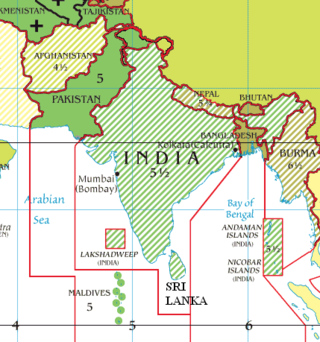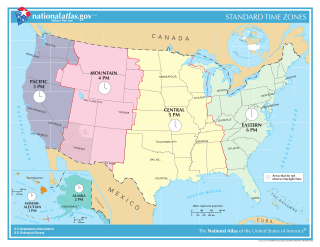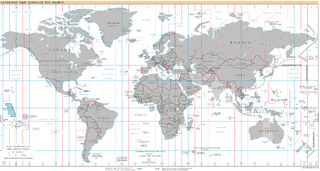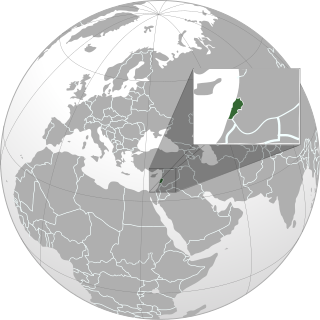
A time zone is an area which observes a uniform standard time for legal, commercial and social purposes. Time zones tend to follow the boundaries between countries and their subdivisions instead of strictly following longitude, because it is convenient for areas in frequent communication to keep the same time.

The North American Central Time Zone (CT) is a time zone in parts of Canada, the United States, Mexico, Central America, some Caribbean islands, and part of the Eastern Pacific Ocean.

Indian Standard Time (IST), sometimes also called India Standard Time, is the time zone observed throughout the Republic of India, with a time offset of UTC+05:30. India does not observe daylight saving time or other seasonal adjustments. In military and aviation time, IST is designated E* ("Echo-Star"). It is indicated as Asia/Kolkata in the IANA time zone database.

In the United States, time is divided into nine standard time zones covering the states, territories and other US possessions, with most of the country observing daylight saving time (DST) for approximately the spring, summer, and fall months. The time zone boundaries and DST observance are regulated by the Department of Transportation, but no single map of those existed until the agency announced intentions to make one in September 2022. Official and highly precise timekeeping services (clocks) are provided by two federal agencies: the National Institute of Standards and Technology (NIST) ; and the United States Naval Observatory (USNO). The clocks run by these services are kept synchronized with each other as well as with those of other international timekeeping organizations.

UTC+14:00 is an identifier for a time offset from UTC of +14:00. This is the earliest time zone on Earth, meaning that areas in this zone are the first to see a new day, and therefore the first to celebrate a New Year. It is also referred to as the "latest time zone" on Earth, as clocks in it always show the 'latest' time of all time zones.

South African Standard Time (SAST) is the time zone used by all of South Africa as well as Eswatini and Lesotho. The zone is two hours ahead of UTC (UTC+02:00) and is the same as Central Africa Time. Daylight saving time is not observed in either time zone. Solar noon in this time zone occurs at 30° E in SAST, effectively making Pietermaritzburg at the correct solar noon point, with Johannesburg and Pretoria slightly west at 28° E and Durban slightly east at 31° E. Thus, most of South Africa's population experience true solar noon at approximately 12:00 daily.

Australia uses three main time zones: Australian Eastern Standard Time, Australian Central Standard Time and Australian Western Standard Time.

UTC−12:00 is an identifier for a time offset from UTC of −12:00. It is the last to enter a New Year, and is sometimes referred to as the International Date Line West time zone (IDLW).
UTC+07:30 is an identifier for a time offset from UTC of +07:30.

The tz database is a collaborative compilation of information about the world's time zones, primarily intended for use with computer programs and operating systems. Paul Eggert has been its editor and maintainer since 2005, with the organizational backing of ICANN. The tz database is also known as tzdata, the zoneinfo database or the IANA time zone database, and occasionally as the Olson database, referring to the founding contributor, Arthur David Olson.
Malaysian Standard Time or Malaysian Time (MYT) is the standard time used in Malaysia. It is 8 hours ahead of Coordinated Universal Time (UTC). Malaysia does not observe daylight saving time.

The time zone in Germany is Central European Time and Central European Summer Time. Daylight saving time is observed from the last Sunday in March to the last Sunday in October. The doubled hour during the switch back to standard time is named 2A and 2B.
Samoa uses UTC+13:00 as standard time. It observed daylight saving time from 2010 to 2021, which it observed during summer in the Southern Hemisphere. In 2011, daylight saving time ended on Saturday, 2 April 2011, 04:00 local daylight time and started on Saturday, 24 September 2011, 03:00 local standard time. Because it is located near the equator, Samoa traditionally did not observe daylight saving time. The introduction of daylight saving time was initially planned for 2009 but was postponed for one year in the aftermath of the 2009 Samoa tsunami.
Time-Sensitive Networking (TSN) is a set of standards under development by the Time-Sensitive Networking task group of the IEEE 802.1 working group. The TSN task group was formed in November 2012 by renaming the existing Audio Video Bridging Task Group and continuing its work. The name changed as a result of the extension of the working area of the standardization group. The standards define mechanisms for the time-sensitive transmission of data over deterministic Ethernet networks.

Time in Lebanon is given by Eastern European Time (EET) (UTC+02:00) or Eastern European Summer Time (EEST) (UTC+03:00) during the summer.
Kiribati, a country in Oceania comprising 32 atolls and reef islands and one raised coral island, observes three time zones, ranging from UTC+12:00 to +14. Kiribati does not observe daylight saving time.
Time in Solomon Islands is given by Solomon Islands Time. Solomon Islands does not have an associated daylight saving time.
The Federated States of Micronesia, a country in Oceania consisting of around 607 islands, observes two time zones, UTC+10:00 in its western part, and UTC+11:00 in its eastern part. Micronesia does not have an associated daylight saving time.












